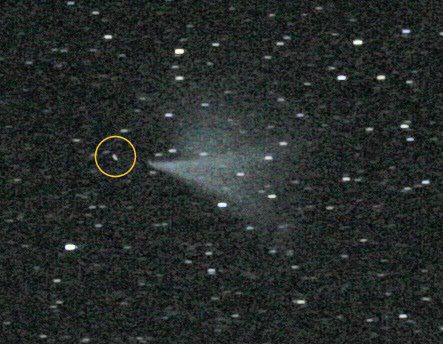Emily Lakdawalla • Nov 29, 2011
Bye-bye, Curiosity
A few fortunate (and forward-thinking) skywatchers looked upward in the hours after Curiosity's launch and were able to see the spacecraft leaving Earth. For the skywatchers in Australia and east Asia, the spacecraft was close enough for viewers to see a transparent plume of gas behind the spent Centaur upper stage, resolved separately from the rover's cruise stage, passing in front of distant stars. Here's a photo, and below that, a really amazing video. Click through to watch this one in 1080p high-definition; at that scale, you're looking at it at the same resolution at which it was originally recorded.

Mars Science Laboratory on its way On the 26th of November 2011, the Mars Science Laboratory was launched from Cape Canaveral. This timelapse sequence shows a plume drifting against the background stars, probably caused by venting from the Centaur rocket after it carried out a burn over the Indian Ocean. This is the fullest set of images available as a timelapse sequence. The original data is the same as the previous two videos, but with extra processing.
This sequence was built from cropped & processed frames (originals: JPEG; 3504x2336, cropped to 1440x1080). The 1080p HD version is therefore scaled 1:1 from the original image files. Exposure details given on image overlay. Observing site: -27.630779,152.966324, altitude 40m approx.
Sir Thomas Brisbane Planetarium colleague Mark Rigby was observing visually, from about 16.15 UT, and assisted with initial analysis of the appearance of the plume. There are more images and discussion of this event on the Planetarium's Facebook page. More info from Duncan Waldron here. (Twitter: @ozalba)Video: Duncan Waldron
About 9 hours later, Austrian amateur observer Gerhard Dangl recorded another lovely time-lapse movie, of a much more distant, star-like Curiosity. In the 36 minutes comprising this video, Curiosity traveled 10,000 kilometers farther from Earth.
Curiosity departs Earth Austrian amateur astronomer Gerhard Dangl captured this video of the Curiosity (Mars Science Laboratory) spacecraft departing Earth about 10.5 hours after its November 26 launch. A still image is available from his website.Video: Gerhard Dangl
How amazing to be able to watch a spacecraft actually departing Earth with your own eyes. One day, will we be able to look up at such a thing, and know that there are humans aboard?
Let’s Go Beyond The Horizon
Every success in space exploration is the result of the community of space enthusiasts, like you, who believe it is important. You can help usher in the next great era of space exploration with your gift today.
Donate Today

 Explore Worlds
Explore Worlds Find Life
Find Life Defend Earth
Defend Earth

